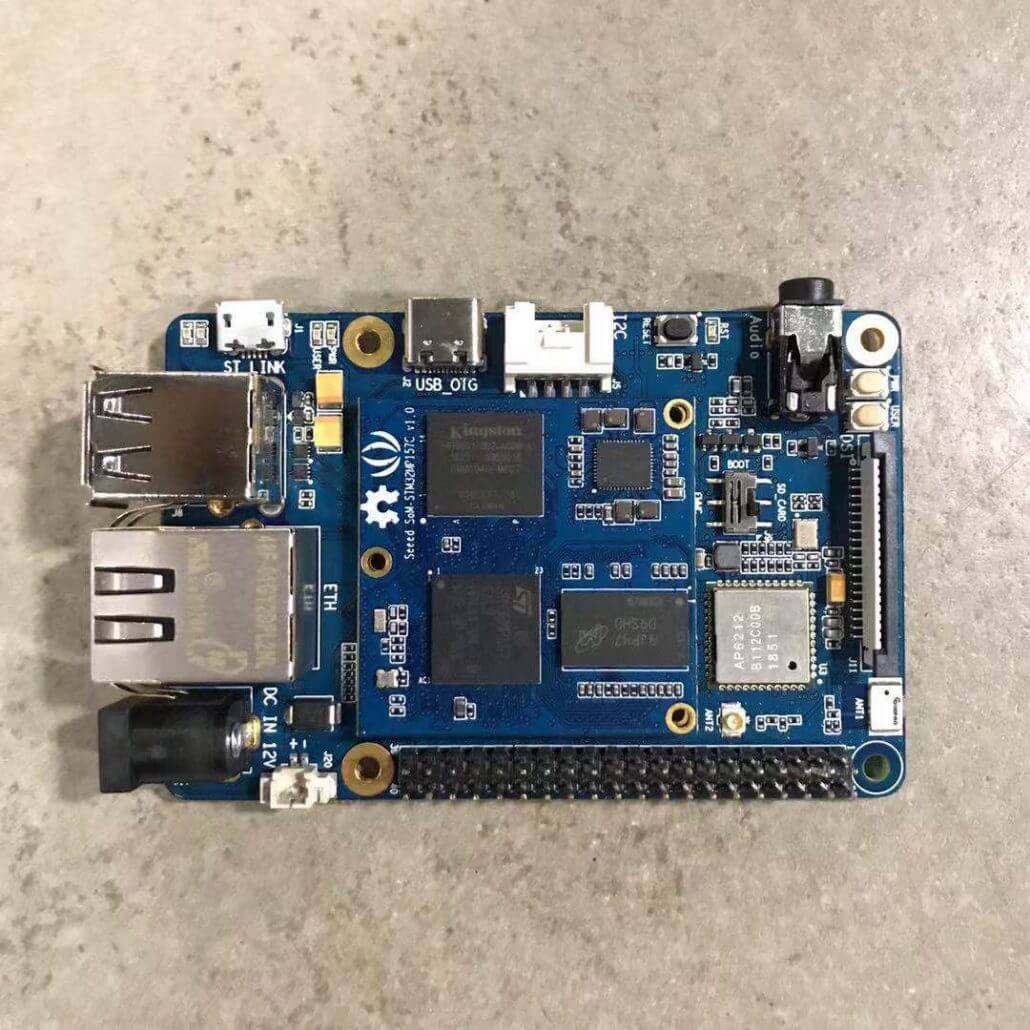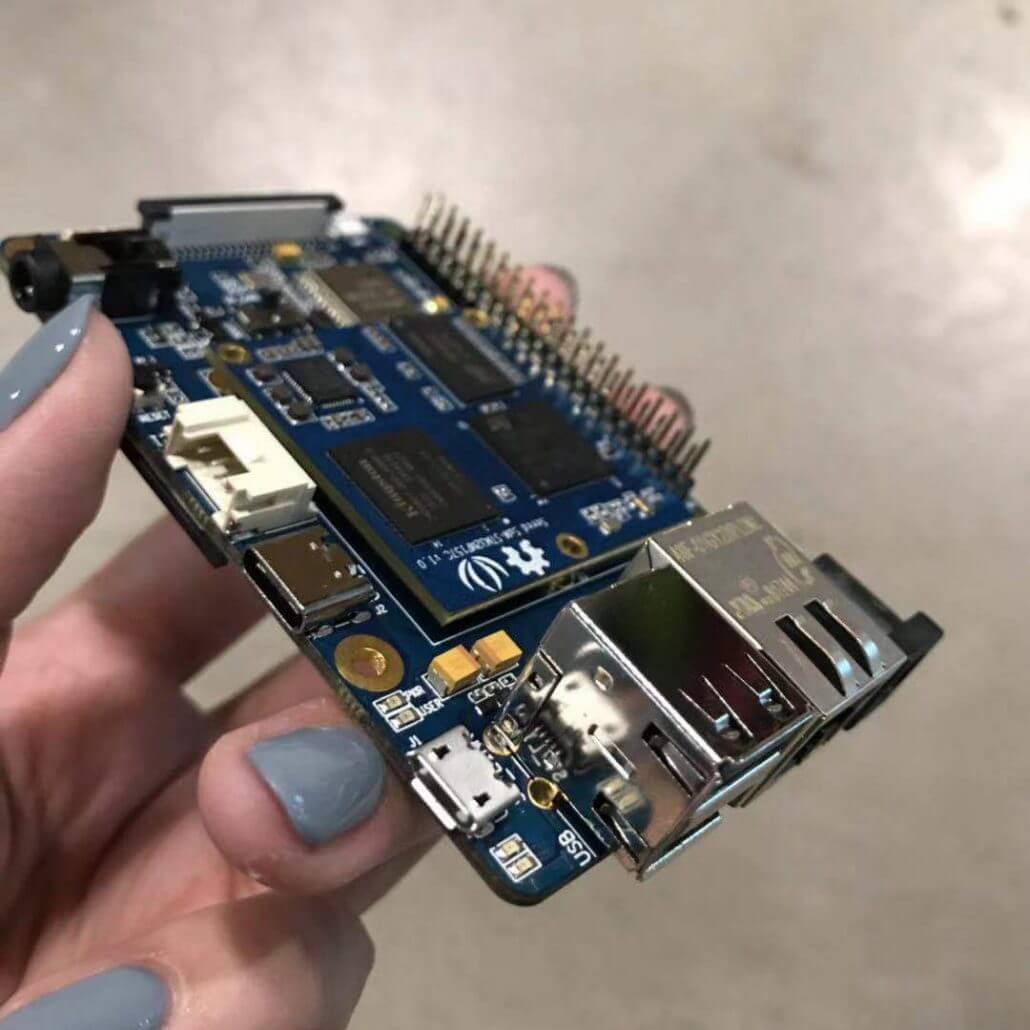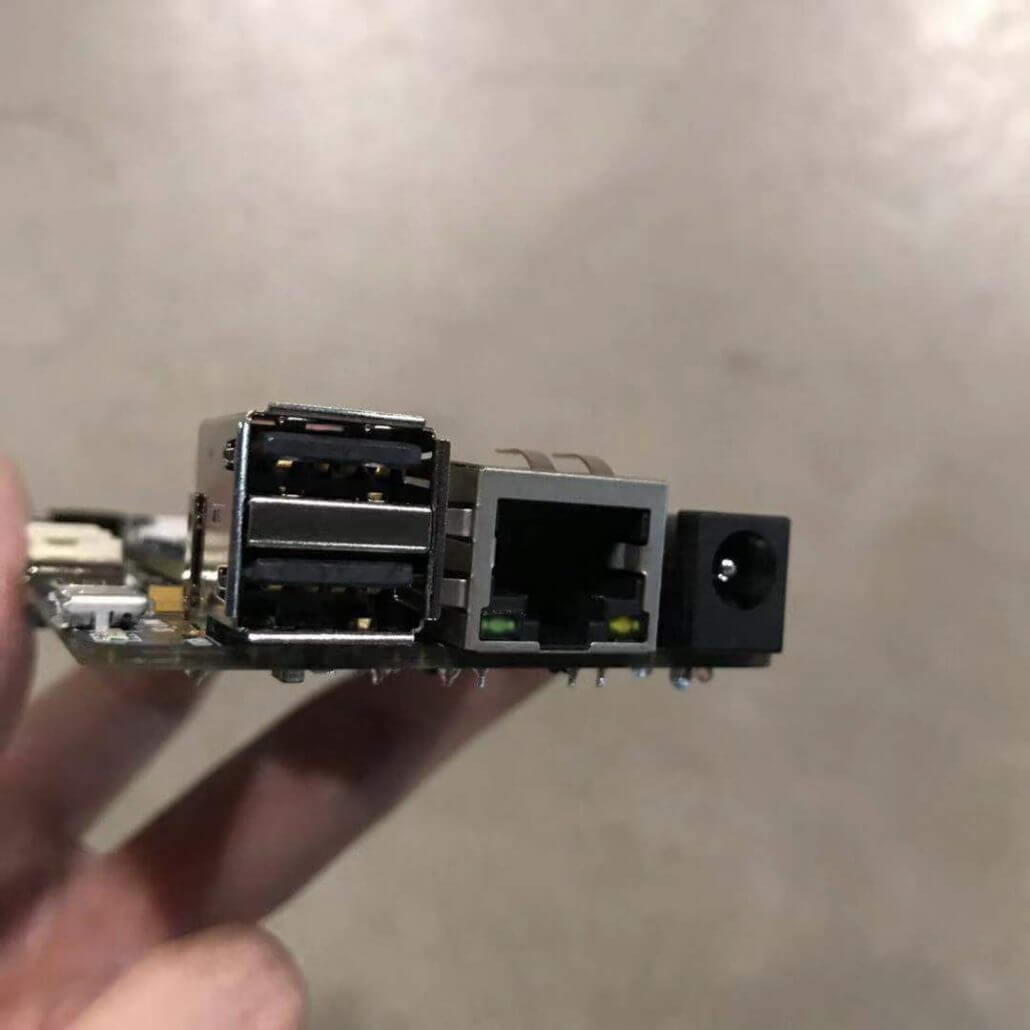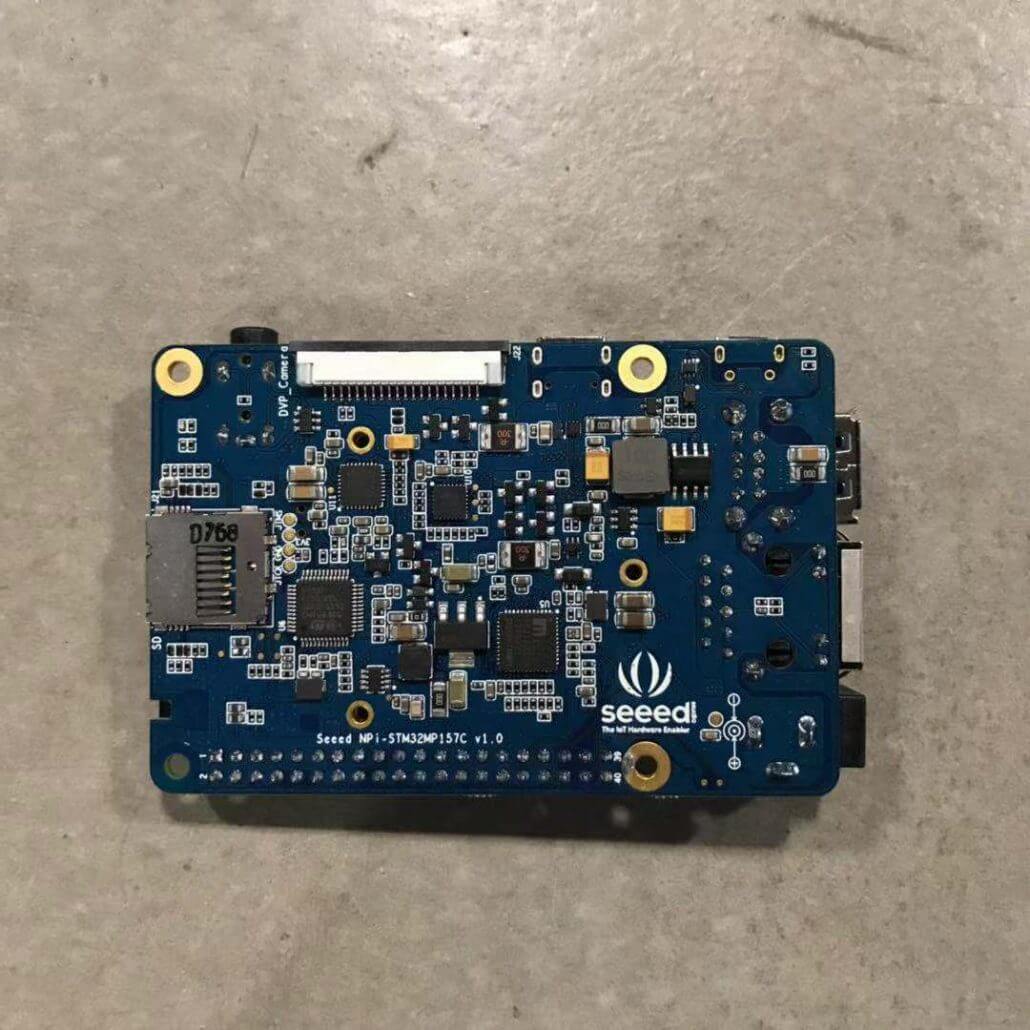The STM32MP157C is the latest MPU that based on the dual-core Arm-Cortex-A7 core operating at 650Mhz. It also embedded a Cortex-M4 for real-time application. It is so far the most powerful microcontroller of ST.
We are excited to announce that we are going to make a development board based on STM32MP1. So that ST developers are able to develop the STM32MP1 more conveniently.
The development board is formed by two parts. The core part is a system on module (SoM), it is a 38mm x 38mm PCBA, includes the STM32MP1, PMIC, 512MB DDR RAM, 4GB eMMC. There are 4 board-to-board 70-pin connectors on the bottom side,and 3 screw hole for more stable assembling.
Then there is a based board. It is a Raspberry Pi form factor board that includes all the necessary peripherals including Gigabytes Ethernet, WiFi/BLE, DC Power,2 USB Hosts, USB-C Power, Li-Po Connector, MIPI-DSI, DVP Camera, audio, etc.
Here is a graphic showing how the product looks like. We are looking forward to more thoughts and ideas from you regarding what kind of features you want to add or remove, what’s your expectation for this product, or you can even give it a name since the product name is not decided yet. And you will have a chance to win a free sample from your ideas.

The latest version just came out! But we will update more based on your suggestions! Please free feel to let us know your thoughts. We will carefully listen to and take action!




Hello there!
I’m amazed to see that SeeedStudio is developing a STM32MP1 board!
Obs: The correct partnumber is STM32MP157C, ok? I think the topic title must be fixed.
What I’d like to see in this board:
- A USB-serial access to the chip, providing access to the Shell console of the Linux running in the board! That is something that I really want to see in this kind of board, and I miss it a lot in the Rasbperry Pi.
- This form-factor of the main processor unit is something that you are developing too? A lot of people are going in the path of the SODIMM form-factor, so this could be something to consider.
- The STM32MP157C has support to HDMI. Wouldn’t be interesting to have HDMI too in the board?
Best regards,
André Curvello
Hi André,
Thanks for your kindly reminder about the part number~ I have updated the topic title. About your comments:
- There will be USB-serial chip on the baseboard, I didn’t list it in the features.
- Regarding the form factor, we choose the current one rather than SODIMM because it looks like SODIMM requires more space. However, we are not quite sure about which form factor is more welcomed by engineers.
- We didn’t include HDMI initially because there is already MIPI-DSI for display, and we need Li-Po connector and Camera interface more than another display.
Best Regards,
Jeremy
This development board seems really powerful and can serve many purposes.
I do not know if these are already planned but I would like to see:
- ST-LINK/V2-1 debugger/programmer
- Grove connectors (Seeed without Grove?)
- GPIO expansion connector (for Raspberry Pi shields) as well as Arduino Uno V3 expansion connectors (For Arduino shields). This double purpose board can take advantage from both of the worlds.
- USB 3.0 (it seems STM32MP157C supports USB 2.0 only but I may be wrong)
- NFC Tag (for provisioning, good for doing something without changing the code)
For the name I can suggest:
Since It is Seeed’s 10th Anniversary so “10 board”. The 10 is also a binary digit which is decimal 2 (basically it is two boards Linux+Arduino). “10” also looks like IO (input/output) or part of IOT. It is a catchy word which is good for branding.
This board does not have enough gpio pins IMO. Considering there is the extra Cortex-M4, there should be at least 32 more GPIO pins (that’s just 2 ports) directly connected to Cortex-M4. Why else should I consider this board compared to, for example, Beaglebone Green that has 2 embedded PRUs and plenty of GPIOs?
How does the data transfer (memory access) between the A7 and M4 works? Would it be possible to mmap the M4 SRAM from within Linux userspace and read/write data? If no, how the data exchange between the CPUs works? If yes, what is the data throughput and what are the latencies of the M4 when the M4 SRAM is accessed by both M4 and A7 at the same time?
Hi yokonav,
Thanks for your feedback.
- There is SWD interface already, so will not add ST-Link/V2-1 in this baseboard.
- Will try to replace the Lipo connector with a Grove connector.
- The Arduino Uno expansion will not be put on this board, otherwise, the board will be too complicated. Will breakout all the Arduino pin to Raspberry Pi 40-Pin, and provide a HAT with Arduino expansion.
- Yes, what STM32MP157C has is USB 2.0. USB3.0 is nice~ however adding USB 3.0 will add quite a lot cost, may consider it if there is a pro version.
- It is interesting to add NFC tag on a development board, do you have a specific application that needs this feature?
Really appreciate and like the idea of “10 board”. I have suggested this name to our branding team. Thank you~
Hi jeremy882,
Thanks for your response.
There are many industrial use cases for NFG tag:
- Upgrade device firmware using the phone/tablet connection.
- Identify breakdown issue and bring the appropriate replacements.
- Check warranty or product registration.
- Read product diagnostics before powering up the machinery.
- Easily obtain product serial numbers, firmware version, repair history.
- Error logs or activity statistics can be read even when the device is completely dead and does not boot up anymore.
I used NFC tag in one of my application where it was needed to modify threshold of a sensor without reprogramming the firmware or touching the board (contactless). Using a tag writer the NDEF record on the tag is modified and the MCU reads the new value from the NFC Tag (connected through serial I2C interface).
Since this development board is very powerful so there are possibilities that it will be used in industrial as well as home-automation system and NFC will enable “tap-and-go” connectivity typically for commissioning a new device in those environments.
Also, a bit extra cost to implement USB 3.0 would give an edge to the board since many Linux development boards coming with USB 3.0 to take advantage of faster data transfer with external storage and adding Neural accelerators.
Hi Yokonav,
Thanks for the detailed example of how to use NFC tag, it really amazed me that there are so many interesting applications with NFC tag on board.
However, there are still factors I need to consider such as the size of the board. We have never added NFC tag to our development board before, it is still a bit risky for us to do so on this one. I am thinking since we will add an I2C Grove connector on the board, and we also have Grove - NFC tag, it is more practical for us to make some nice demo with Grove - NFC tag at the very beginner. We will do more evaluation on adding the tag on the main board in the future.
Regarding the USB3.0, I have consulted our electrical engineer, and they don’t think this would work as the STM32MP1 only supports USB2.0, there will always be a bottleneck from the speed of USB2.0. And also I have searched google and could not find a solution for that. Please correct me if I am wrong or miss any information from your suggestion.
Still, really appreciate your ideas~
Jeremy
Hi Jeremy882,
I can understand your concerns. You are right, with groves modules we can extend the functionality. I am eager to use this board. When can we expect this board in the production?
Hi Ole00,
Thanks for figuring out this important issue. Actually, we have a plan to break out the Cortex-M4 to the raspberry pi standard 40-pin connector, and will provide an Arduino HAT in the future, do you think this is an acceptable solution for you?
From the block diagram in the datasheet, we can see that the data transfers between the A7 and M4 via multi-AHB bus and AXI bus. Theoretically, the M4 and A7 can’t access the SRAM at the exact same time but might be able to access and switch in a very short time.
Jeremy
Thanks for your understanding. We will have the samples in Middle July, and if everything goes well, it will be released in early September.
Great!
I’m happy to see the comments here.
Well, I think it’s possible to “route” pins in the SoC GPIO between the A7 and the M4, right?
So, based on that, the 40-pin Raspberry Pi connectors should not be a problem.
Exposing the SWD is excellent to use it with the ST-Link V2 (or equivalent).
Thanks for the reply about the USB-Serial and display.
So, the focus of this SBC, for now, is to use it with display or “headless”, right?
Any updates?
Hi Yokonav,
Thanks for the following up. We will get the first batch of sample this week. Will update the photos here once we get the samples.
The latest version just came out! But we will update more based on your suggestions! Please free feel to let us know your thoughts. We will carefully listen to and take action!




Hi!
This is a great initiative!
Which port the Grove connector provides? I hope I²C.
Which SDK (or SDKs) do you plan to use for the Cortex-M4 core? Apart from STM32Cube, do you plan to consider the Wiring/Arduino framework!
Good luck with the development!
Wow! Looks great! Have you decided the name yet?
It is probably too late. But the Arduino mega 2560 form factor would be nice.
Many people(me included) use a RaspberryPi with an Arduino mega2560 and Ramps board for 3d printing. With a meaga2560 form factor and a 3.3V Ramps board this board could be a much better solution for 3d printing. It would be better because it would replace the Arduino and the Raspberry. And it would also have much more performance on the real time part. That would help with complicated movement especially with Delta printers. Octoprint could run in the Linux section, Marlin 2.0 could run on the M4 section.
The 40-pin connector, if RaspberryPi compatible does have less than 40 GPIO and it would not be enough to drive a printer. Therefore as said in a much earlier post. More GPIO would be better !!!
From the performance point of view the most recent RaspberryPis will be much better on CPU power. So the real benefit of this CPU is the integrated Cortex-M4. And that is best for real time control stuff. And therefore the M4 needs as many Pins as possible! (GPIO, SPI, I2C, UART)
Hi reivillo,
The Grove port is I2C ![]()
I am sorry that for now we are not considering the Wiring/Arduino framework.
Hi Yokonav,
The name is decided already.
For the SoM, it is Seeed SOM-STM32MP157C. This is the most understandable name for our users, and we will have more SOM in the future us SOM+IC Name.
For the SoM+Based Board, we call it the NPi-STM32MP157C. “NPi” looks simple and easy to remember, the word “NPI” also means “New Product Introduction” in the product development process, which means a good start. Also, we hope our users don’t consider this product as Pi, “NPi” also means “Not Pi”.
Hope you like the idea ![]()